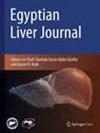Lifestyle determinants as predictor of severity of metabolic associated fatty liver disease (MAFLD)
IF 0.7
Q4 GASTROENTEROLOGY & HEPATOLOGY
引用次数: 0
Abstract
Abstract Background Metabolic-associated fatty liver disease (MAFLD) is a public health issue that can result in liver cirrhosis and its complications. Aim of work Assess the dietary pattern, physical activity, and sleep quality of MAFLD patients. Methods Cross-sectional study of 77 MAFLD patients being present in the outpatient clinic of Endemic Medicine Department at Cairo University Hospital. An interview questionnaire including sociodemographic, medical history, validated food frequency questionnaire (FFQ), Pittsburg Sleep Quality Index (PSQI), and international physical activity questionnaire (IPAQ) were utilized to collect data. Results Among patients, 36%, 34%, and 30% had liver steatosis grades I (mild), II (moderate), and III (severe) respectively. Waist circumference, body mass index (BMI), daily caloric and carbohydrate intake, impaired sleep quality, and low physical activity were significantly linked with steatosis grades. The independent significant predictors for MAFLD severity were waist circumference ( P = 0.011, OR 1.119), poor sleep quality ( P = 0.038, OR 3.871), habitual sleep efficiency (OR 3.402, 95%CI 1.403–8.252), daytime dysfunction (OR 2.487, 95%CI 1.374–4.501), and physical activity ( P = 0.027, OR 4.6). Conclusion Waist circumference, poor sleep quality, habitual sleep efficiency, daytime dysfunction, and low physical activity were the real marked predictors for MAFLD severity.生活方式决定因素作为代谢性脂肪肝(MAFLD)严重程度的预测因子
背景:代谢性相关脂肪性肝病(MAFLD)是一个可导致肝硬化及其并发症的公共卫生问题。研究目的:评估mld患者的饮食模式、身体活动和睡眠质量。方法对开罗大学医院流行内科门诊77例MAFLD患者进行横断面分析。采用包括社会人口学、病史、有效食物频率问卷(FFQ)、匹兹堡睡眠质量指数(PSQI)和国际身体活动问卷(IPAQ)在内的访谈问卷收集数据。结果36%、34%和30%的患者为肝脂肪变性I级(轻度)、II级(中度)和III级(重度)。腰围、身体质量指数(BMI)、每日热量和碳水化合物摄入量、受损的睡眠质量和低体力活动与脂肪变性程度显著相关。MAFLD严重程度的独立显著预测因子为腰围(P = 0.011, OR 1.119)、睡眠质量差(P = 0.038, OR 3.871)、习惯性睡眠效率(OR 3.402, 95%CI 1.403-8.252)、白天功能障碍(OR 2.487, 95%CI 1.374-4.501)和体力活动(P = 0.027, OR 4.6)。结论腰围、睡眠质量差、习惯性睡眠效率、日间功能障碍和低体力活动是预测MAFLD严重程度的真正显著因素。
本文章由计算机程序翻译,如有差异,请以英文原文为准。
求助全文
约1分钟内获得全文
求助全文

 求助内容:
求助内容: 应助结果提醒方式:
应助结果提醒方式:


